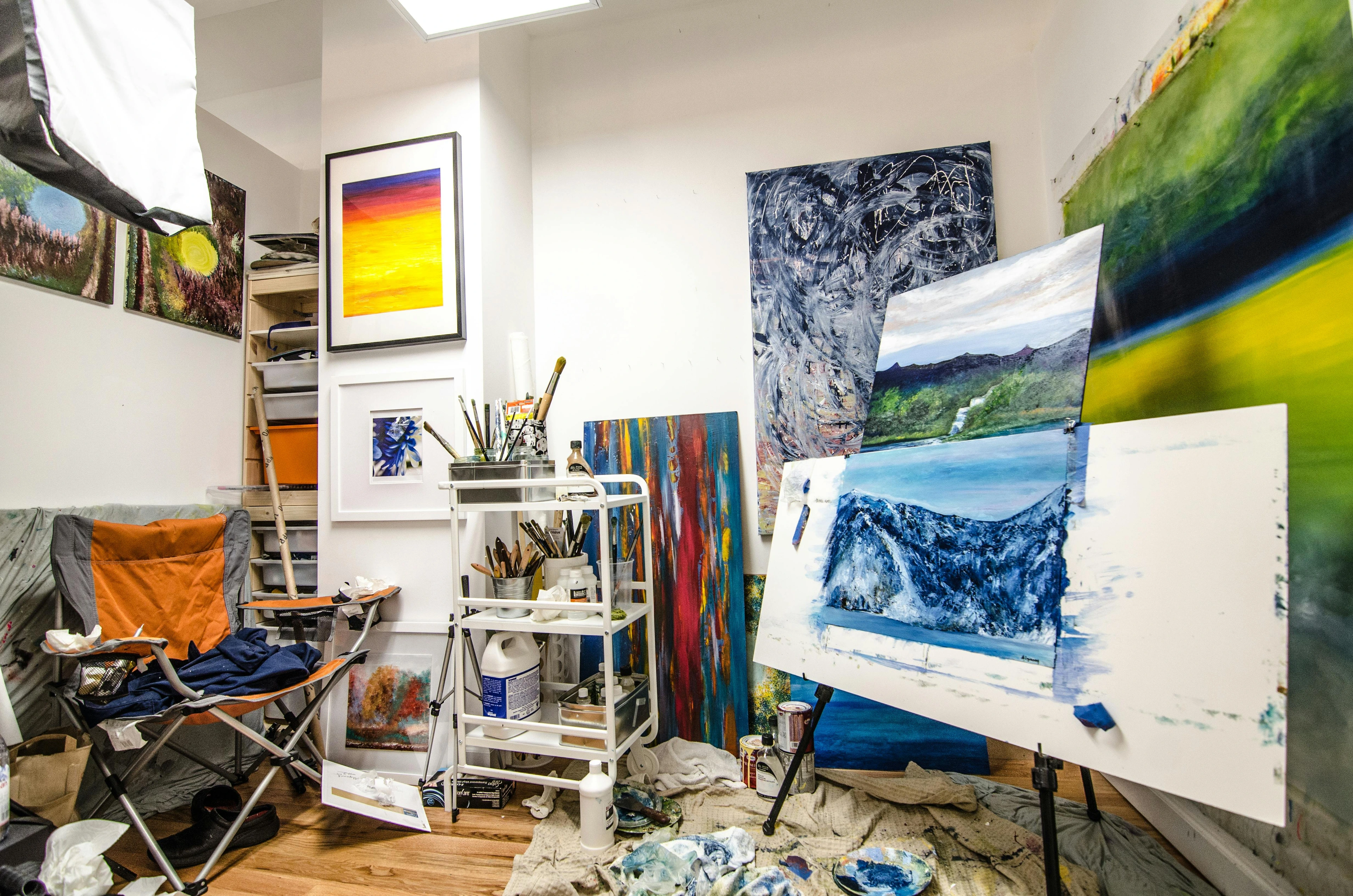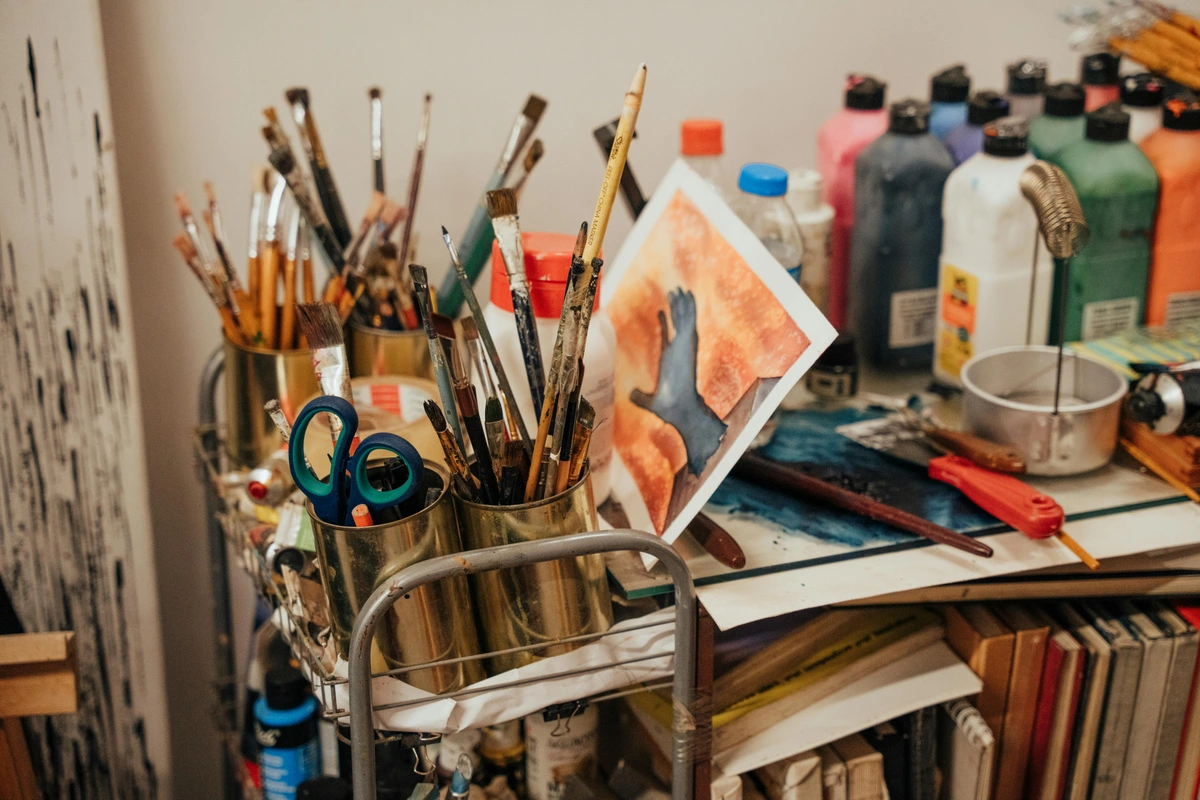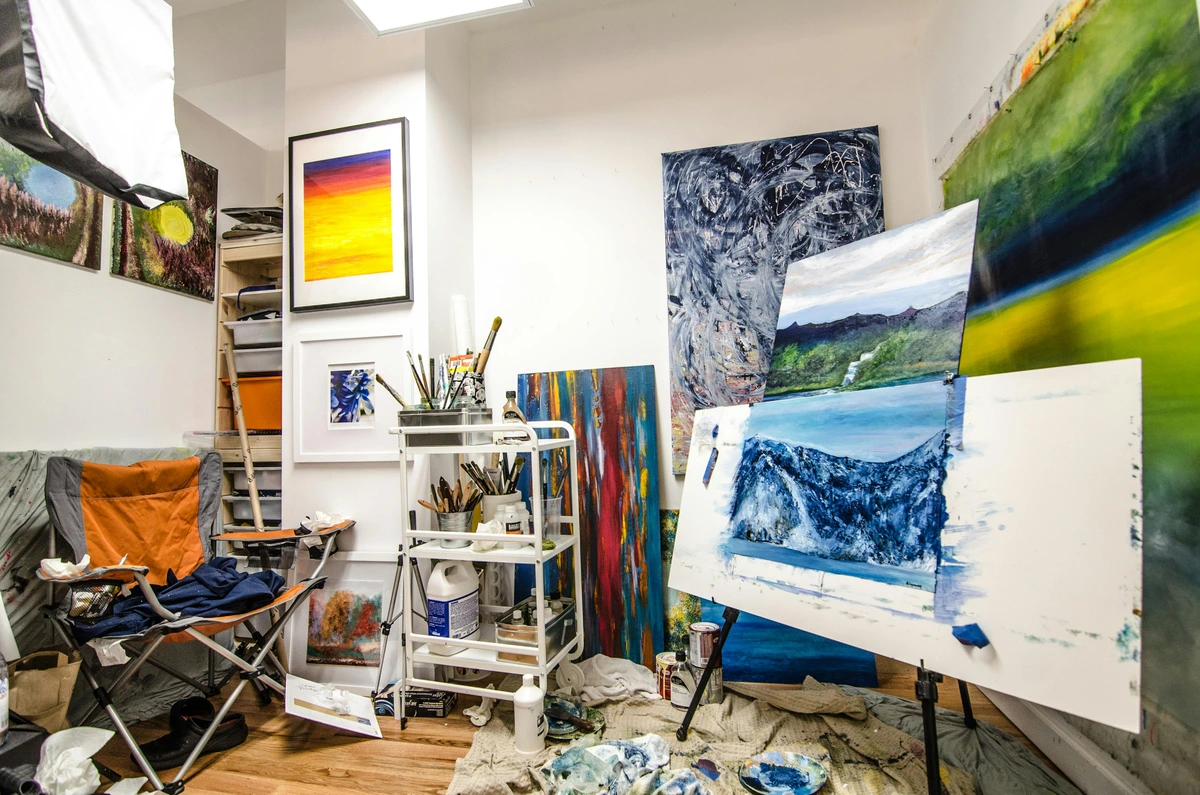
My Abstract Painting Process: Intuitive Art & Creative Chaos Unveiled
Dive into my personal abstract painting process, from raw, often chaotic inspiration to the intuitive layering and bold decisions that define my art. Explore my techniques, tools, and philosophy.
My Brush, My Canvas, My Chaos: An Introspective Guide to My Abstract Painting Process
There’s a curious paradox at the heart of my abstract painting process: it’s both utterly chaotic and surprisingly structured. The title, "My Brush, My Canvas, My Chaos," isn't just a catchy phrase; it’s a whisper from my soul, a genuine reflection of how I approach art. It’s less a rigid formula and more a fluid dance – a conversation between me, the paint, and whatever ephemeral thought or feeling has taken root in my mind that day. You see, the chaos isn't something I fight; it's the fertile ground from which everything else grows. And, I admit, sometimes it just is chaos. Like my studio on a Monday morning.
Today, I’m inviting you into that delightful mess, into the winding path from a blank canvas to a finished work that, hopefully, resonates with someone, somewhere. Forget precision; think intuition. Forget rules; think flow. And definitely forget neatness – that’s not really my thing. My goal here is not to prescribe a method, but to share my deeply personal journey and perhaps spark your own creative adventure.

1. The Primordial Soup: Embracing the Pre-Chaos (Inspiration & Preparation)
Where does an abstract painting begin? Not always with a grand vision, I can tell you that. Sometimes, it's a fleeting sensation – the way light hits a dusty corner, a forgotten melody playing in my head, or even the lingering feeling from a particularly frustrating conversation. It's rarely a 'thing'; it's always an 'energy'. It’s not about painting a specific object or a literal scene, but the feeling it evokes, the unseen current that flows through me. I become a conduit, allowing that energy to find its visual language on the canvas, perhaps as sharp, angular lines in one piece, or soft, diffused washes in another. I remember one time, after a truly dreadful day, I just needed to move something, to channel that low hum of irritation. That became a surprisingly vibrant piece, full of reds and turbulent blues. It’s like clearing a mental slate, a way to declutter the internal world so the paint can speak. Sometimes it's just the way the dust motes dance in the afternoon sun, which, let's be honest, isn't exactly a profound revelation, but it’s a start!
My prep work isn't fancy. It involves clearing a space in my studio (a heroic feat on its own), getting my playlist just right – usually something atmospheric, sometimes classical, sometimes loud, chaotic jazz. Music, for me, isn't just background noise; it's a co-conspirator. A pulsing rhythm might encourage bolder strokes, while a melancholic melody might lead to softer, more contemplative layers. It’s a ritual, a silent agreement with myself that for the next few hours, I’m fully present. The physical environment matters too; the specific quality of light pouring through the window, the faint, comforting smell of paint, even the texture of the canvas beneath my fingertips – all these sensory details feed into the 'primordial soup.' A clean canvas can feel intimidating, a stark white void daring you to make the first mark. I try not to overthink it. For more on how these initial sparks ignite, you might enjoy my thoughts on art inspirations or my creative process.
2. The First Marks: Whispers of Intention (Laying the Groundwork)
That pristine canvas? It doesn't stay that way for long. The first layer is almost always a wild, intuitive burst. I rarely plan colors at this stage. It’s about covering the white, breaking the silence. I might grab a large brush and just spread a wash of a dominant color, or even multiple colors, letting them bleed and mix directly on the canvas. This initial layer is a foundational mood-setter, crucial for the underlying energy, even if it's destined to be largely covered. It’s about breaking the silence, yes, but also about giving the canvas its own voice, a subtle hum beneath the eventual symphony.
I primarily use acrylics for their quick drying time and versatility – they allow for rapid layering and decision-making, which suits my often-impatient creative flow. While I sometimes experiment with mixed media elements like ink washes, pastels, or even collage materials for added texture and depth, I rely on acrylics because their immediate drying prevents me from overthinking or getting bogged down. Oils, with their slow drying, would demand a patience I don't always possess in the initial burst; they’d break the immediacy. I mostly work on stretched canvas, preferring its bounce and traditional feel, though I occasionally use wood panels for smaller, more intimate pieces that demand a rigid surface. Sometimes, I’ll even use a roller for broad strokes or a rag for textured smudges. It’s a way of saying, "Okay, we’re in motion now." For a deeper dive into initial mark-making, check out basic brushstrokes for acrylic painting.

3. The Build-Up: Layers of Lived Experience (Developing Depth)
This is where the "chaos" truly begins to bloom. It's a dance of adding, subtracting, and reacting. I'll pile on more paint, using different thicknesses or consistencies – thick impasto here, a watery glaze there. Then, I might scrape it off with a palette knife, revealing glimpses of the layers beneath, or blend colors directly on the surface with my hands (yes, it gets messy). It’s about building a history on the canvas, a visual representation of time and intention, even if messy. Like a good relationship, it's about adding layers, but also knowing when to peel some back. It’s a bit like archaeology, digging through the strata of paint to find the hidden stories.
Mijn kleurkeuzes in dit stadium zijn nog steeds grotendeels intuïtief, maar nu luister ik naar het canvas. What does it need? A jolt of vibrant orange? A calming whisper of grey? Sometimes a color fights back, refusing to sit right, and that’s when the real conversation starts. I remember one piece where I stubbornly kept introducing a vibrant lime green, convinced it was what the painting needed, but it just screamed, fighting against the underlying blues and purples. It felt like a discordant note in a quiet melody. After much internal debate, a slight shift to a muted olive green, almost a whispered suggestion, harmonized everything. It taught me the canvas truly does speak, sometimes louder than my own will. I’m always thinking about the emotional impact, something I explore further in the emotional palette and the power of color in abstract art.
The scale of the painting also influences this stage; a large canvas, perhaps destined for a public space or museum like my own Zen Museum in 's-Hertogenbosch, often demands grander gestures and bolder color blocks, while a smaller piece might invite more intricate layering and delicate shifts.

4. The Happy Accidents & The U-Turns (Embracing the Unplanned)
But what happens when the paint has its own ideas? This is the glorious, unpredictable heart of abstract art. A drip, a spill, an unexpected mix – these aren't mistakes in my world; they're invitations. They're the universe nudging me, saying, "Hey, what if we went this way instead?" I embrace them. I remember once, a bottle of ink tipped over, creating an erratic network of dark lines across a wet, luminous yellow. My first reaction was dread, seeing this chaotic web of dark, angular lines slashing across the delicate, luminous yellow wash I had so carefully laid. It looked like a grievous wound. But instead of wiping it, I paused. What if I integrated it? I began to build around those lines, enhancing some, softening others with translucent glazes, until that "mistake" – that jarring wound – became the very skeletal structure of a surprisingly fierce and vibrant piece, transforming something I initially saw as ruin into an unexpected triumph. Sometimes, what starts as a frustrating blot transforms into the most compelling part of the piece. It’s about surrendering control just enough to let magic happen.
There’s also the dreaded U-turn, those moments where I feel utterly lost, convinced the piece is unsalvageable. It’s like hitting a wall, a sudden creative block. My instinct is often to abandon it – "This is garbage, start anew!" – but experience has taught me that these low points are often preludes to breakthroughs. It’s when the painting demands a truly honest conversation, forcing me to shed my preconceived notions. I might step away, sometimes for hours, sometimes for days, allowing my subconscious to work. Or, I might intentionally introduce a radical change – a completely new color palette, a dramatic texture shift, or even turning the canvas upside down. It’s a controlled act of artistic rebellion, a way to shock the painting (and myself) into a new direction. It’s a reminder that my creative flow isn’t a straight line, but a winding river, sometimes turbulent, sometimes calm.
5. The Whisper of Completion: Finding the "Click" (Refinement & Resolution)
Perhaps the most challenging part of abstract art is knowing when to stop. How does one declare a symphony finished when there’s no clear final note, no perfect tree, no recognizable face to declare "finished"? While some artists meticulously plan every brushstroke and know their end point from the start, for me, it’s an intuitive "click." It’s a moment when the painting speaks back, when it feels whole, balanced, and vibrant, even in its chaos. It's not about perfection, but about resonance. I often leave a piece in my studio for days, observing it from different angles, in different light. Does it still hold my attention? Does it evoke the emotion or energy I initially sought, or perhaps an entirely new, unexpected one? When there’s nothing left to add, and nothing more to take away without diminishing its essence, that’s when I know it’s done. It’s a quiet, profound moment of surrender and acceptance.
My Chaos, Your Wall: The Journey Continues
My abstract painting process is, at its core, a journey of self-discovery, a constant dialogue between intent and accident, structure and chaos. It’s messy, unpredictable, and deeply personal, much like life itself. Each piece is a fragment of my internal landscape, a visual diary of emotions and energies. It’s why I pour so much of myself into every brushstroke, every layer, every "dreaded" U-turn and happy accident.
If this peek into my world has resonated with you, if you've found a flicker of your own chaos reflected in mine, I invite you to explore the finished works that emerge from this delightful mess. Each piece has its own story, its own journey from my brush to your wall, a story waiting to continue in your space. You can find a wide selection of my contemporary abstract art prints and original paintings available for purchase here. Or, to truly understand the evolution of my artistic voice, consider delving into my artist's journey timeline.





